IntelliJ IDEA basics
Theory
The main goal of IntelliJ IDEA is to raise your productivity while you are writing code. We prepared some basic advice to level up the speed and comfort of your developing experience. Those are for common cases, but you can also find more on the IntelliJ IDEA webpage.
§1. Use keyboard shortcuts
We encourage you to use keyboard shortcuts, because they can significantly speed up your coding and even reduce the risks of Repetitive Strain Injury. IntelliJ IDEA is a keyboard-centric IDE. You can choose one of the pre-configured shortcut schemes, or a keymap, in File | Settings | Keymap:
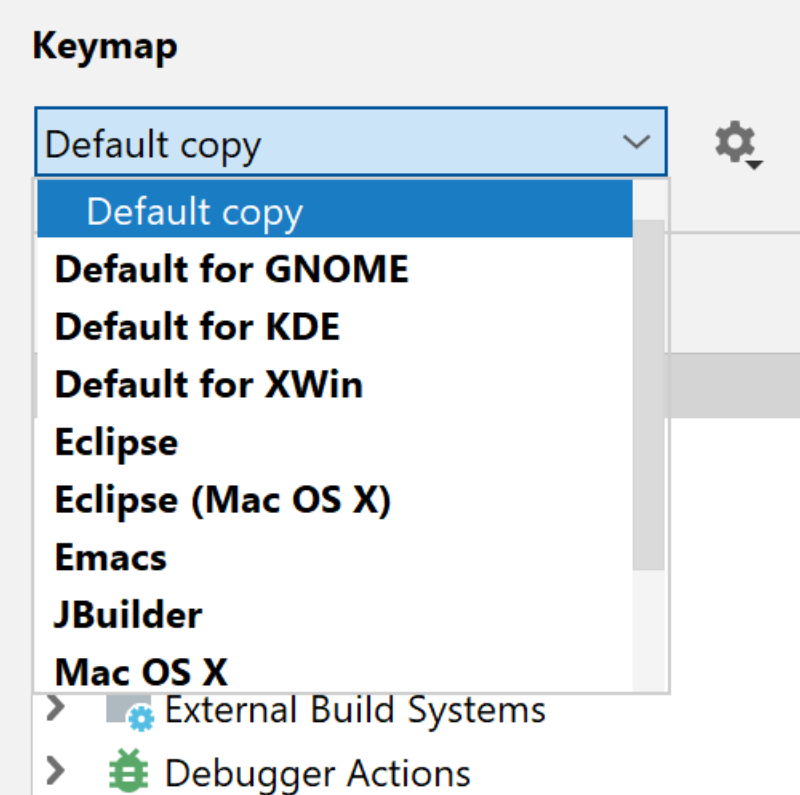
You can always take a closer look at the list of actions and corresponding shortcuts available via search:
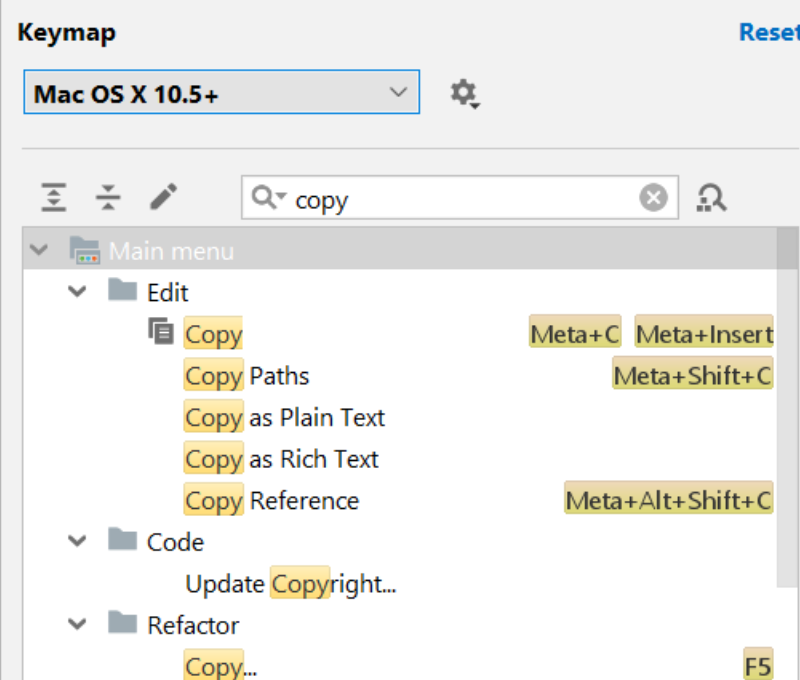
Or, you can search for action by shortcut:
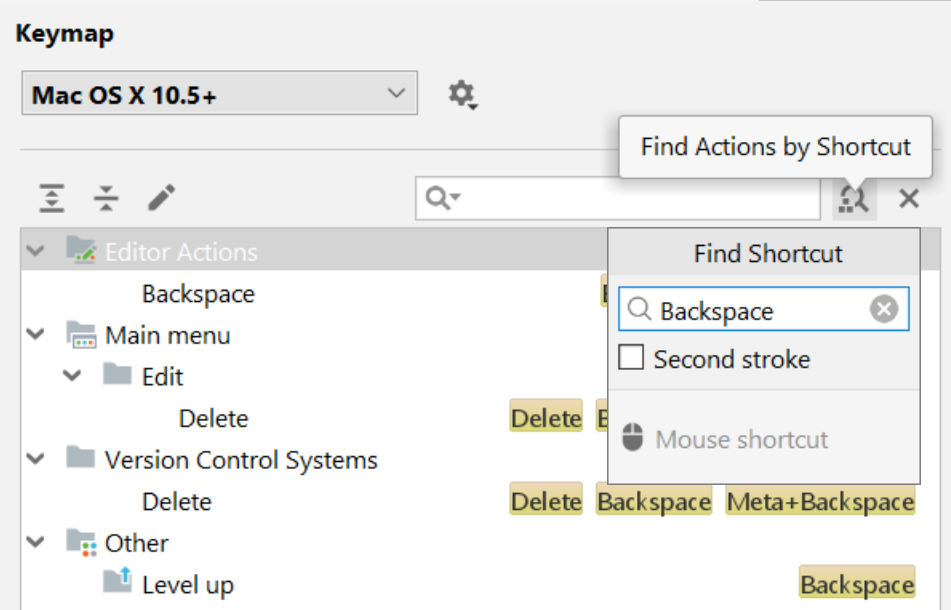
You can also set up your own keymap if you need a customizable list of shortcuts.
Note: If you use the default keymap of your OS and want a nice-looking cheat sheet to print out, go to Help | Keymap Reference for macOS or Help | Keyboard Shortcuts PDF for Windows.
§2. Go to the dark side
IntelliJ IDEA initially uses the default light color scheme, but you can always switch to the dark Darcula scheme. You can switch to it in File | Settings | Appearance & Behaviour | Appearance by choosing Darcula under the Theme dropdown list:
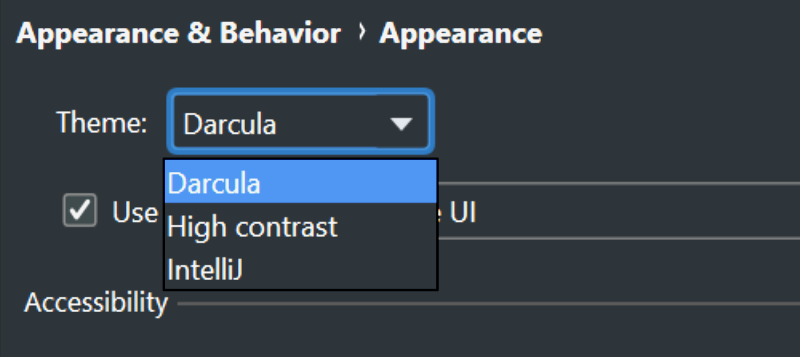
Note: you can use ⌃ ` (in macOS) or Ctrl + ` (in Windows and Linux) to switch quickly between color schemes and keymaps.
§3. Local Terminal
IntelliJ IDEA features a local terminal that makes it possible to access the command line. Depending on your platform, you can work with the command prompt, PowerShell, Bash, etc. Using the terminal, you can execute any command without leaving the IDE.
To run the console, press ⌥ F12 / Alt + F12 or click the Terminal tool window button:
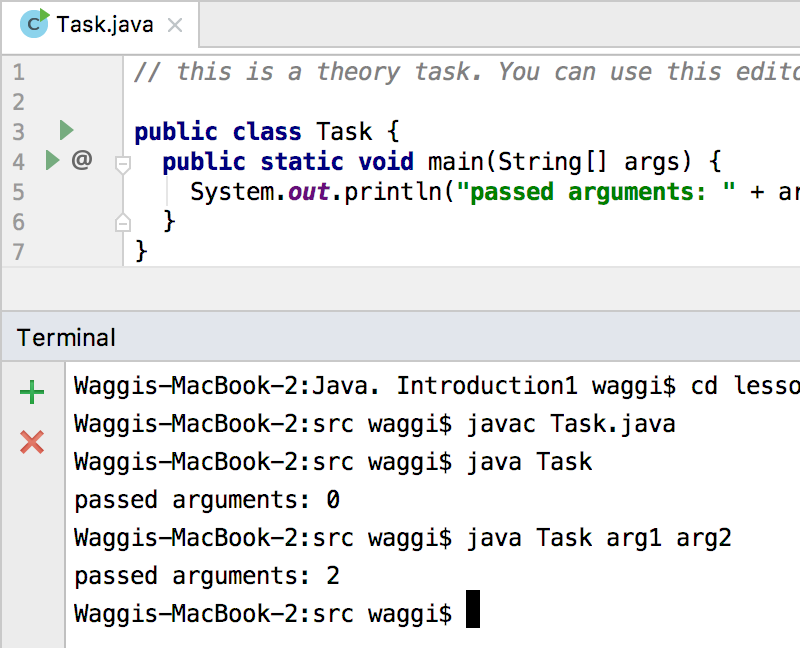
§4. Conclusion
IntelliJ IDEA allows you to:
- choose the scheme of keyboard shortcuts in File | Settings | Keymap and take a look for the shortcut you need by searching
- change the theme in File | Settings | Appearance & Behaviour | Appearance
- open the terminal by ⌥ F12 / Alt + F12 or press the Terminal window button
Now you have a solid background on how to use common IntelliJ features. It is time to put them into practice!
You can also view Lesson on hyperskill.org.
Practical tasks and answers
Tasks and answer options are given. The correct option is highlighted in blue color.
№1. Shortcut schemes
Question: Where can one find pre-configured shortcut schemes?
Select one option from the list:
- there are no shortcut schemes in IntelliJ IDEA
- in File | Settings | Shortcuts
- in File | Settings | Keymap ✔
- in a special pre-installed search app
Explanation. The pre-configured shortcut schemes can be found in File | Settings | Keymap in IntelliJ IDEA.
№2. Darcula
Question: What is Darcula in IntelliJ IDEA?
Select one option from the list:
- Developers' Application Readability Culture
- A dark color scheme for IntelliJ IDEA ✔
- A font with bloody letters
- A name of the terminal in IntelliJ IDEA
Explanation. Darcula is a dark color scheme for IntelliJ IDEA.
№3. Find shortcuts
Question: How can you quickly find shortcuts to the actions you need in IDEA?
Select one option from the list:
- locating it in Help | Getting started
- by using "search" tool in File | Settings | Keymap ✔
- by checking all the information in File | Settings | Keymap
- locating it in Navigate | Shortcuts
Explanation. You can quickly find shortcuts to the actions you need in IntelliJ IDEA by using the "search" tool in File | Settings | Keymap.
№4. Shortcuts
Question: What is the purpose of keyboard shortcuts?
Select one option from the list:
- They are for people who can not afford a mouse
- They make you read faster
- They speed up your coding ✔
- They provide access to more sophisticated features
Explanation. The purpose of keyboard shortcuts is to speed up your coding.
№5. Command terminal
Question: When can you access the command terminal in IntelliJ IDEA?
Select one option from the list:
- Always ✔
- During the installation process
- In the Command Mode
- Never, you need to install it independently
Explanation. You can access the command terminal in IntelliJ IDEA always.
№6. Run the IntelliJ IDEA terminal
Question: What can one use in order to run the IntelliJ IDEA local terminal?
Select one or more options from the list:
- Alt + F / ⌥ F
- View | Tool Windows | Terminal ✔
- Alt + F1 / ⌥ F1
- Alt + F12 / ⌥ F12 ✔
Explanation. To run the IntelliJ IDEA local terminal, you can use the following options: View | Tool Windows | Terminal; Alt + F12 / ⌥ F12.
№7. Why IntelliJ IDEA?
Question: Why may one want to use IntelliJ IDEA?
Select one option from the list:
- It is the only way to write an executable code
- It is a trendy application
- It is pre-installed on every os
- It provides useful features to speed up development ✔
Explanation. One may want to use IntelliJ IDEA because it provides useful features to speed up development.
№8. Change the theme
Question: Which short-keys can be used to quickly switch between color schemes and keymaps?
Select one or more options from the list:
- ⌥ + F12
- Ctrl + ` ✔
- ^ + ` ✔
- Alt + F12
Explanation. The short-keys that can be used to quickly switch between color schemes and keymaps are: Ctrl + `; ^ + `.
How to use the main functions of IntelliJ IDEA?
IntelliJ IDEA is an integrated development environment (IDE) that provides a wide range of features to help developers write code efficiently. Some of its main functions include:
- Code editing: IntelliJ IDEA provides a code editor with features such as syntax highlighting, code completion, and refactoring tools. This makes it easier for developers to write, read, and modify code.
- Debugging: IntelliJ IDEA has a built-in debugger that allows developers to identify and fix errors in their code. It provides features such as breakpoints, watches, and stack traces to help developers troubleshoot issues.
- Version control: IntelliJ IDEA integrates with version control systems such as Git, Subversion, and Mercurial. This makes it easier for developers to manage code changes and collaborate with others.
- Build tools: IntelliJ IDEA supports build tools such as Gradle and Maven. This allows developers to automate the build process and manage dependencies more efficiently.
- Testing: IntelliJ IDEA provides tools for testing code, including unit testing and integration testing frameworks. This helps developers ensure that their code is functioning correctly.
To use these functions in IntelliJ IDEA, developers can use the various menus, toolbars, and keyboard shortcuts provided by the IDE. They can also customize these settings to suit their workflow and preferences.